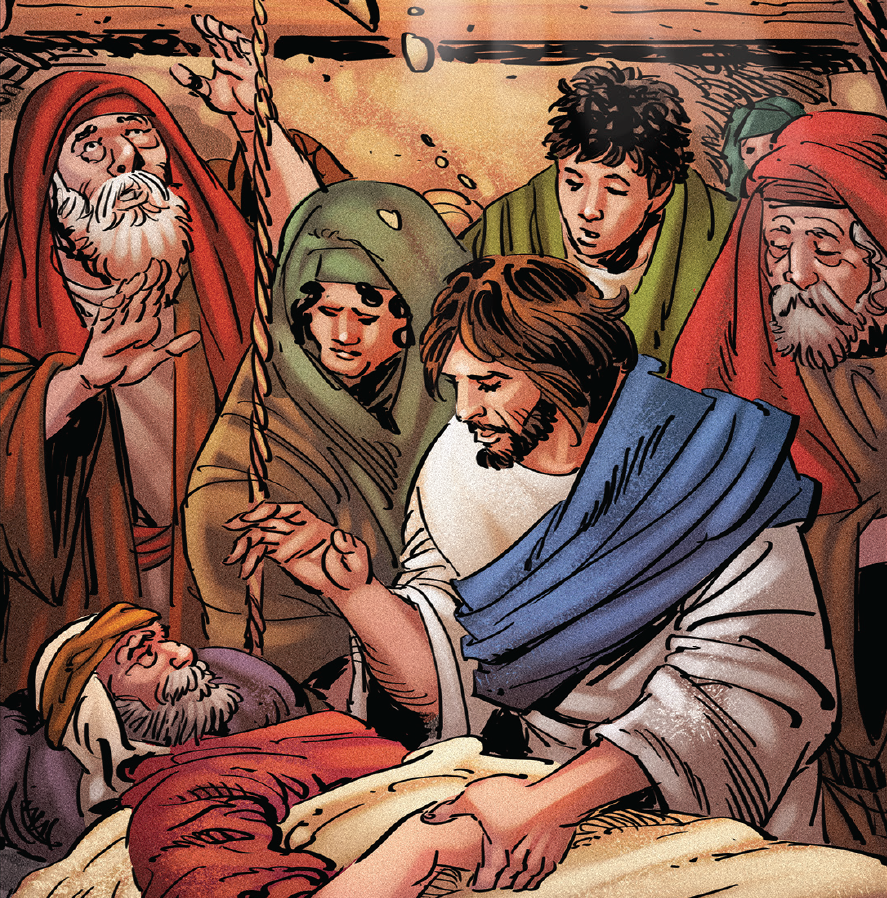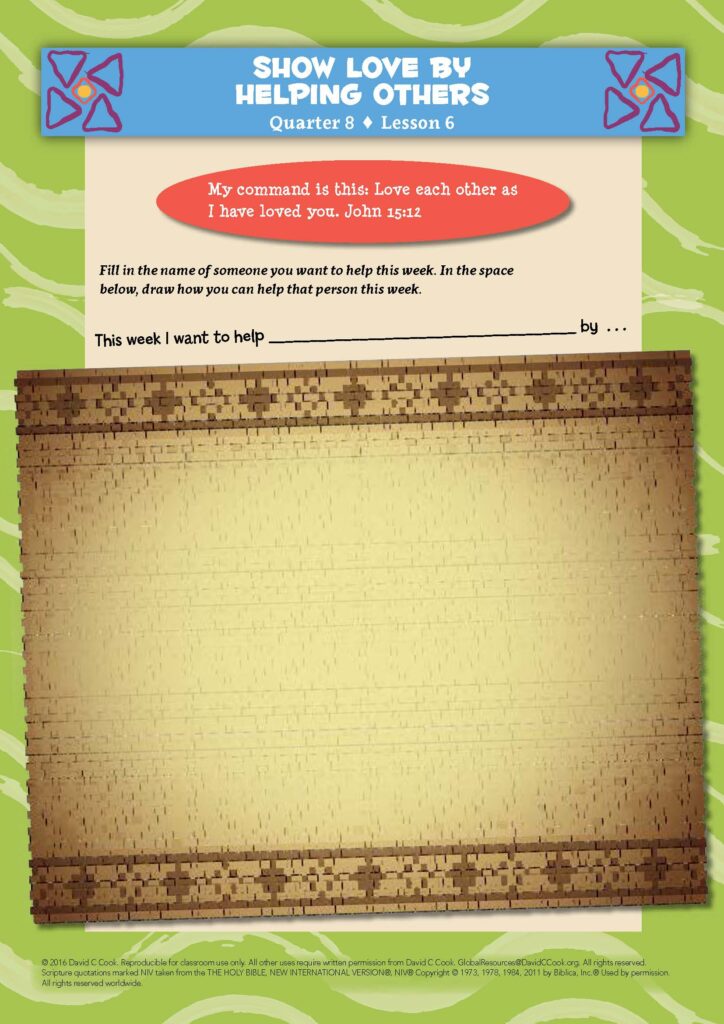During the lesson, the information for you to know is written in regular type, and what we suggest speaking or reading aloud to children is in bold. All resources for this lesson, including the Teacher Guide, Student Page, Family Connection Card, and other resources can be downloaded in a ZIP file by clicking on the following link:
In some lessons you will find "resource articles." These are articles written by experts from around the world to help equip you for your work with children and adolescents. Share them with parents or guardians if you consider it appropriate.
We love because [God] first loved us.
1 John 4:19
God first loved us. Love is His idea. He is the source of love and shows us how to love. We can only love as we stay connected to His love. When we fully receive God’s unconditional love, it changes the way we treat others. His love moves us to show love to others in ways we may never have thought to do before. We begin to notice the needs of people around us and see how we can help them.
So what does love do? It acts! It sees people and responds to their needs. Love is what moves us to comfort, help, encourage, correct, and support others. Love is what causes us to put forth the effort to bring others to Jesus, just as the 4 friends brought the paralytic to Jesus. This week ask God to fill you with all the fullness of His love. Then let it splash out of you and onto others as you look for ways to help.
Tell families that their children will learn that they can show love by helping others. Encourage them to think of ways their family can help someone else this week.
Teacher Tip: If possible, email or text the Family Connection Card to the families of your students.
As your children arrive, ask them about last week. Did any of them experience the love of God at a certain time? Allow children who want to share to do so briefly with the class. Share your own story. Keep the sharing time to no more than 5 minutes.
Let the children know you will start with a game. Mark a starting line and a finish line. Divide the children into teams of 5 or 6.
We will have a race. Each team will have to work together to carry someone across the finish line. Each team will choose 1 teammate to carry from the starting line to the finish line. This person will pretend that he has hurt his leg and needs to be carried to the health clinic at the finish line. The first team to cross the finish line wins. All teammates must be holding the person you are carrying. The person you are carrying cannot touch the ground at all or you must start over again.
If you notice any teams that are good at helping each other, encourage and congratulate them. After the game, tell the children that this game was based on a Bible story they may know. Allow them a minute to guess what the story is.
Optional: If possible, share the image from The Action Bible.

Listen to Jesus’ words to us in John 15:12:
My command is this: Love each other as I have loved you.
John 15:12
What does Jesus tell us to do in this verse?
Love each other.
Tell the following story to your children. There are several places where you will pause and read 3 different ways that the story might continue. Let the children pick the one they think is correct. The correct one is underlined for you.
Jesus wants us to love each other just as He loves us. Sometimes that is easy to do and sometimes it can be hard to do. One way we can show love to others is by helping them.
Today you will hear a Bible story about 4 friends who showed love to their friend by helping him in a very important way. You may have heard this story before. I will pause several times and read 3 different ways the story might have continued. You will pick the one you think
really happened.
Jesus was teaching in someone’s house. The house was crowded with people because everyone was eager to hear Jesus. There were 4 friends who wanted to bring their paralyzed friend to see Jesus, but they could not get in.
What do you think the friends did?
That’s right! The friends dug a hole in the roof and lowered the man down to Jesus. When the man was placed right in front of Jesus, He looked at the paralyzed man on the mat.
What do you think Jesus did?
Not all sickness is caused by the bad things we do. However, each and every person is a sinner who needs forgiveness. Jesus knew this and forgave the paralytic because He was concerned about his physical sickness as well as his heart sickness.
When Jesus forgave the man’s sins the religious teachers there thought to themselves, “What is Jesus saying? This is blasphemy! Only God can forgive sins.” Of course, Jesus knew what they were thinking because He is God.
So Jesus asked the religious leaders a question. What do you think He asked them?
You are right, He asked them if it was easier to forgive the man’s sins or tell the man to stand up and walk. Jesus forgave the man’s sins, but He did not stop there. Everyone in the room was listening to see what Jesus would do.
What did Jesus say to the man?
Can you imagine how the man felt when Jesus told him to pick up his mat and go home? Imagine if you had been there and had seen this miracle. Right before your eyes, you would have seen the man get up and grab his mat. Just moments before he had been paralyzed and unable to walk. Then he walked out the door. Everyone was amazed.
What do you think the people said?
That’s right, the people had never seen anything like that before. What an amazing thing they witnessed, and it started when 4 friends decided to help a paralyzed man!
Optional: If you are using The Action Bible, have the children review the story on pages 560–562.
Now divide the children into pairs. Ask each question and give the children a minute to answer with their partners. Ask 1–2 pairs to share their ideas with the class.
Who was the most loving in this story?
After the children answer, point out that Jesus is the most loving if they do not mention it. He healed the man’s heart as well as his body.
Read John 15:12 to the children. Invite the children to say it with you. Repeat it in a whisper and then shout it out. Ask the children to repeat it again without your help.
If you are using the Memory Verse Poster, show it to the students.
My command is this: Love each other as I have loved you.
John 15:12

As we said at the beginning of today’s class, sometimes it is easy to show love to others and sometimes it can be difficult. Jesus does want us to obey Him, but He wants us to love others because we have received His love. Then we can love others because we have His love in our hearts.
Close your eyes for a moment. Think about how much Jesus loves you. As we learned last week, He loves you when you are choosing to do good things and even when you choose to do wrong things. He loves you when you are having happy days and when you are experiencing difficulties. He wants to fill you up with His love. If you want to receive it now, cup your hands in front of you as though they are being filled with water. Then pretend to drink it in.
Now open your eyes. Let’s think about ways we can obey Jesus’ command and love others as He loves us. Think quietly of your answers.
Think of 1–2 people you can love by helping them this week.
What is 1 thing you can do help them this week?
As your children think quietly, suggest several practical ideas. For example, they might show
love to their mother by helping her carry water. They might show love to a friend by helping him with schoolwork.
Invite your children to stand up and share how they want to help this week. They can say something such as, “This week I want to help (name of person) by (what I am going to do).”
Optional: If you are using Student Pages, there is space for children to draw pictures of the people they choose to help and what they will do to help.

Close class by praying this blessing based on 1 John 4:19 over the children.
Blessing: We love others because Jesus first loved us! May you be filled up with Jesus’ love so you can show His love by helping others this week!
Lead the children in singing this quarter’s song, if possible.
Life on Life ©2020 David C Cook. Reproducible for home or classroom use only. All other uses require written permission from David C Cook [email protected]. All rights reserved.